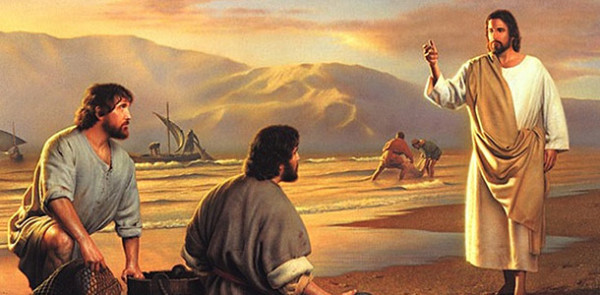Did Jesus Exist? An Alternate Approach
by Jimmy Akin
Filed under Historicity, Jesus
Discussions of this subject often begin by looking at references to Jesus in early Christian sources.
Either that or they look for references to Jesus in early non-Christian sources.
But there’s another way of looking at the question that is often ignored . . .
The Standard Approach
Jesus is obviously mentioned in early Christian sources, such as the gospels, the other writings of the New Testament, and the works of the early Church fathers.
Because these are Christian sources, though, their evidence is sometimes discounted, and so an appeal is made to references in early non-Christian sources that mention Jesus.
He is mentioned, for example, in the writings of a number of Roman writers who lived in the early 100s. He’s also mentioned, somewhat more controversially, in the writings of the first century Jewish historian, Josephus.
But an objection is sometimes made to these sources as well: It is suggested that they don’t represent independent evidence for the existence of Jesus, because the authors in question only know about Jesus from what they have learned from Christians.
In some cases, this may be true. In other cases, it may not be true. Some of these authors may have had access to records that conveyed information about Jesus independent of the Christian movement.
But suppose that they didn’t. Suppose that all of the information presented in these sources is ultimately derived from Christian sources.
This does not leave us at an impasse, because there is another approach to the question that we can take.
References to Christianity
Instead of looking, in the first instance, for references to Jesus, we can look at references to the Christian movement itself and see what we can learn about it.
Of course, the same sources that refer to Jesus tend to refer to the Christian movement. That means that we can quickly establish a number of quite early references to Christianity.
It is mentioned by:
- Suetonius, writing around A.D. 121
- Tacitus, writing around A.D. 116
- Pliny the Younger, writing in A.D. 110 or 111
- The Emperor Trajan, writing back to Pliny in A.D. 110 or 111
- And Josephus, writing around A.D. 93
The inclusion of Josephus in this list is not dependent on the famous Testimonium Flavianum found in his Antiquities 18:3:3.
Even setting aside that reference, which is partially corrupted, Josephus elsewhere refers to Jesus having followers (noting that he “was called Christ”) in a passage for which we have no evidence of manuscript corruption (Antiquities 20:9:1).
We thus have multiple references for the existence of a Christian movement that date to the end of the first century and the beginning of the second.
Geographical Spread
These same references indicate a considerable geographical spread for the movement.
Josephus is writing about events in Judaea, which other sources also indicate was the origin point of the movement.
But Suetonius and Tacitus write about the movement existing at Rome as well.
And Pliny the Younger indicates that it was widespread in Bithynia (in modern northern Turkey).
A Recent Movement
Another notable fact about the Christian movement is that it was of recent origin.
This is something also indicated by the same sources, who place its origin in the first century.
Josephus links Jesus to his “brother” James, who died in A.D. 62 (Antiquities 20:9:1).
Pliny is at a loss for how to deal with this religious movement, which is so new that the way to deal with its members is still in the process of being established (Letters 96).
Suetonius specifically says that Christians were a new movement (The Twelve Caesars: Nero 16).
And Tacitus says that Jesus was “executed during the rule of Tiberius by the procurator Pontius Pilate” (Annals 15:44).
All of this points to a first century date for the origin of the movement.
The Christians Agree
The earliest Christian sources agree with all this. They acknowledge that Christianity began in the first century.
This is significant, because it would not be in the early Christians’ interests to claim this.
Newness is not, on balance, a desirable trait in promoting a religion.
It is much easier to promote a religion if you can claim antiquity for it.
That’s why even religions of indisputably recent origin—including Scientology, Mormonism, and the New Age movement—invariably link themselves to some form of supposed ancient wisdom.
And the early Christians did this, pointing the origins of their movement in Judaism.
They pointed to this as a way of offsetting the fact that their movement had its particular origin just a few years earlier.
We can thus take their testimony of a recent origin as credible, for if the Christian movement had been older, they would have claimed that it was older.
Narrowing the Range
We can narrow the range of Christian origins further, though.
Pliny indicates that some of the people he interviewed had been Christians as many as twenty years previously. Working backward from when he was writing, that would suggest Christians in Bithynia by A.D. 90.
Tacitus and Suetonius both speak of Christians being in Rome during the reign of Nero (A.D. 54-68), and Suetonius possibly alludes to them being there during the reign of Claudius (A.D. 41-54; see The Twelve Caesars: Claudius 25).
When we turn to Christian sources, we find Luke indicating that John the Baptist began his ministry in the fifteenth year of Tiberius Caesar (Luke 3:1), which is most naturally taken as a reference to A.D. 28.
This is significant because all four of the gospels indicate that the Christian movement began after the ministry of John the Baptist had begun.
A Rapidly Spreading Movement
These sources thus allow us to discern a portrait of a rapidly spreading movement.
It apparently began in the Roman province of Judaea some time in or after A.D. 28.
It spread as far as Rome no later than A.D. 54-68 (and quite possibly earlier).
And it had spread to Bithynia no later than A.D. 90.
This portrait is derived from just a few sources. If we were to allow other first and second century sources to speak, it would be easy to show that the movement was in other places as well, including Syrian Antioch, Ephesus, Corinth, Thessalonica, Philippi, and many other locations.
What we see is thus a movement that went from not existing to being dramatically spread around the Roman world in just a few decades.
This tells us something important about the early Christian movement . . .
It Was Organized
Movements do not spread that way unless they are organized.
This was particularly the case in the ancient world, where travel was slow, difficult, dangerous, and often expensive.
The spread of Christianity was not an accident. It was the result of a deliberate strategy of evangelization that required significant organization.
This tells us something else . . .
It Had Leaders
Organization requires leaders. There have to be people organizing the movement and arranging for its message to spread.
The book of Romans expresses this need from a Christian viewpoint as follows:
Everyone who calls on the name of the Lord shall be saved.
But how are they to call on one in whom they have not believed?
And how are they to believe in one of whom they have never heard?
And how are they to hear without someone to proclaim him?
And how are they to proclaim him unless they are sent? [Rom. 10:13-15].
Developing Organization
Early Christian writings reveal quite a bit about how the Christian movement was organized and how its organization developed during the first century of its existence.
We see it quickly being organized into local groups known as churches.
These had local officers including bishops, priests, and deacons.
The churches themselves, though, tended to be planted, especially in the early days, by individuals known as apostles and evangelists.
The sources we have—including the documents of the New Testament, the writings of the early Church Fathers, and even spurious writings like the Gnostic gospels—indicate that the earliest work was done by those officials who were called “apostles.”
The Greek term for apostle—apostolos—conveys the idea of someone who has been sent, which raises a question . . .
Who Did the Sending?
Movements tend to have founders—especially highly organized movements.
Any time you have a sizeable, well-organized movement, there is often a single figure at its inception who played a key role in setting it up, developing its vision, and putting in place the leaders who carried it forward.
Even in movements that form when a number of similarly-minded movements come together and merge, there is usually a single figure who takes the prime leadership role.
So when we see Christianity as a geographically diverse organization that spread remarkably quickly and had leaders known as apostles (“sent ones”) founding local congregations, it’s only natural to look at the movement and ask whether it, too, had such a founding leader.
According to the early Christians, it did, and it is here that we encounter the figure of Jesus.
Jesus of Nazareth
The earliest accounts we have agree that Jesus of Nazareth founded the Christian movement, recruited and trained its earliest leaders, and then sent them out as his apostles.
This is simply what you would expect of an organization that displayed the sudden appearance and growth of the Christian movement, and there is no good reason to reject the movement’s own account of its origins on this point.
The sudden appearance and rapid growth of Christianity points to a level of organization and motivation that is most naturally explained by the movement having a single, recent, and charismatic founder.
Not Unique to Christianity
This reasoning does not apply just to Christianity. It also applies to other movements that suddenly appear and grow quickly.
For example, it applies to Islam.
Islam did not exist prior to the early A.D. 600s, and within the first 150 years of its existence it spread dramatically, ranging all the way through North Africa, to the Middle East, to India (with a European foothold in Portugal and Spain).
That kind of expansion required organization.
In Islam’s case, the organization was political and military, but it still pointed to the existence of a single, recent, charismatic founder—Muhammad—who established the movement, provided its vision, and gave it its early organization and motivation.
The Reality of Jesus
You would expect a movement that began and then spread far and wide in only a few decades to have a founder, and—absent very strong evidence to the contrary—it does not make sense to reject the movement’s claim about who its founder was.
From non-Christian sources alone, we could have predicted that Christianity likely had a founder who lived some time in the first half of the first century.
When we find Christian sources agreeing with this and identifying that founder as Jesus of Nazareth, we have reason to credit this claim and to conclude: Jesus of Nazareth existed.
What Now?
If you like the information I've presented here, you should join my Secret Information Club.
If you're not familiar with it, the Secret Information Club is a free service that I operate by email.
I send out information on a variety of fascinating topics connected with the Catholic faith.
In fact, the very first thing you’ll get if you sign up is information about what Pope Benedict said about the book of Revelation.
He had a lot of interesting things to say!
If you’d like to find out what they are, just sign up at www.SecretInfoClub.com or use this handy sign-up form:
Just email me at jimmy@secretinfoclub.com if you have any difficulty.
In the meantime, what do you think?
Related Posts
Note: Our goal is to cultivate serious and respectful dialogue. While it's OK to disagree—even encouraged!—any snarky, offensive, or off-topic comments will be deleted. Before commenting please read the Commenting Rules and Tips. If you're having trouble commenting, read the Commenting Instructions.













